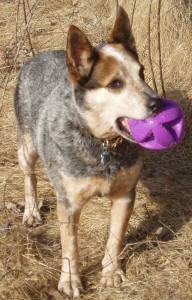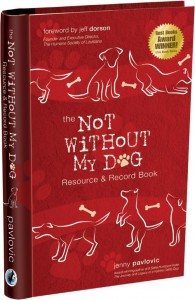With hurricane and summer storm season beginning, I was recently invited to be on a radio show called ‘Heroes of Katrina: Ten Years After – Hurricane Preparedness for Pets’. To get ready for the show, I reviewed my classic post, ‘8 Things I learned from 8 State Kate’, the cattle dog who was rescued after Hurricane Katrina and who later came to live with me as she recovered and I looked for her original family. I found the information to be useful still, and added updates from what I’ve learned in the past few years.
While you may not live in hurricane country, your area is vulnerable to some type of severe storm and natural disaster. We live in Minnesota, where storms can cause flash flooding and knock out power, the river can rise rapidly and overtop its banks, and tornadoes blow through every summer. In the winter we get blizzards, which can also knock out power. The point is that everyone needs to be prepared for the type of disaster that can occur in their area. Being prepared means having a plan for your family, including your animals.
Here are eight things I learned from 8 State Hurricane Kate.
1. Microchip your pet. In the aftermath of Hurricane Katrina, we learned how easily pets can lose their collars and IDs. A microchip implanted under the pet’s skin is the best permanent identification. I recommend a microchip even if your pet never leaves the house. A flood, tornado, hurricane, or even a surprise bolt out the door can separate you. A microchip is a small electronic chip with a unique ID number, in a capsule the size of a grain of rice. When a pet is found, the ID number is read by a hand-held scanner and the microchip company is notified. The company looks up the ID number in their database to find the owner. A microchip will only reunite you with your pet if you’ve registered your current contact information. Microchip technology has improved over the past ten years. A universal scanner is now available that can read the microchip number from any manufacturer.
2. Keep good pet records, including a current photo of you with your pet (to verify ownership) and photos of your pet’s unique identifying characteristics. Store your pet’s vet, food, and medication records in one place (like The Not Without My Dog Resource & Record Book – Click here for more information). Include information on the pet’s daily routine, words the pet knows, and other useful tips for anyone taking care of your pet in an emergency situation. Make sure a designated person knows where your pet’s information is stored, in case something happens to you. Print the photos of you and your pet; don’t rely on photos stored on your phone. If power is lost, you may lose power to your phone too.
3. Make a disaster plan for your family and pets. Know the most likely natural disasters in your area. If you must stay home in a disaster situation, be prepared to survive without assistance. Assemble a kit to meet your family’s basic needs for at least three days. Store it in easily accessible waterproof containers. If you must evacuate, do not leave your pets behind. Have carriers, leashes, and harnesses for your pets. Know the local evacuation routes, how you’ll transport your pets, and where you’ll take them. Plan alternate destinations because emergency shelters for people often don’t allow pets, and pet-friendly hotels fill quickly.
4. Make a family communication plan in case a disaster occurs while you’re separated. Know where your family will meet if you can’t reach each other by phone. Identify a neighbor or pet sitter who will get to your pets quickly when they need help and your family is away from home.
5. Make sure your pets get good nutrition (including Omega Nuggets and Canine Shine) and are properly vaccinated, treated for fleas and ticks, on heartworm preventative, and spayed or neutered. Healthy pets are better prepared to survive anything, including displacement and housing with other animals. Accepted vaccination protocols are changing, and some flea and tick treatments are not approved by veterinarians. Do your research and decide what’s best for your pet.
6. Socialize and train your pets. Help your pets learn to be confident in different situations. Positively trained pets are less likely to get lost. Make sure they know how to walk on a leash/harness and are comfortable riding in their carriers in the car. Teach them to wait before exiting the car by pausing, then giving them a reward. I feed my cat in her carrier twice each day. Since she’s used to going in the carrier and doesn’t think twice about it, I could easily load her into the carrier on short notice if needed. We also have a harness for her and put it on her regularly, so she’s used to it and I can remember how to put it on.
7. Tune in to your pets. They’re tuned in to you. Give them opportunities to do what they were bred to do. Help them relax and be confident. Appreciate them for who they are. The more connected you are to your pets, the better you will weather anything together.
8. Be flexible and resilient. An old girl who has lost everything can recover with dignity and grace, and be happy. Kate taught me this too.
This article includes information from Noah’s Wish, www.NoahsWish.org.
The Not Without My Dog Resource & Record Book is available at www.8StateKate.net.
Every year on June 2nd, in memory and honor of Katrina cattle dog Kate, we celebrate Kindness for Kate Day. On June 2nd, please perform a new act of kindness for a person or animal. We hope these new acts of kindness will become habits and make the world a better place. Thank you.
Posted on May 30th, 2015 Filed under: Book Tour--Virtual, General, Not Without My Dog



Leave a Reply
You must be logged in to post a comment.